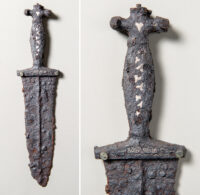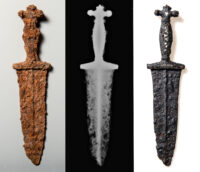 A Roman dagger discovered near the village of Tiefencastel in the Alpine canton of Graubünden has been restored revealing rich decoration of inlaid silver and brass. Its cross-shaped handle dates it to 50 B.C., an extremely rare type of which only four examples are known.
A Roman dagger discovered near the village of Tiefencastel in the Alpine canton of Graubünden has been restored revealing rich decoration of inlaid silver and brass. Its cross-shaped handle dates it to 50 B.C., an extremely rare type of which only four examples are known.
The pugio was found in May 2019 by metal detectorist Lucas Schmid who volunteers to employ his hobby on behalf of the Archaeological Service of Graubünden (ADG). He was scanning an area of the Crap Ses Gorge in the Oberhalbstein Alps where Roman legions battled the Rhaeti in 15 B.C. and established a summer military camp to control the Septimer Pass. Roman lead sling bullets and weapons have been discovered there since 2003.
 Schmid found the heavily corroded dagger a foot beneath the surface. It was complete, albeit missing its scabbard. next to a gladius, the short double-edged sword that was standard issue for Roman legionaries and local auxiliaries. He alerted the ADG to his finds and archaeologists followed up with an excavation at the site this September. In one month, the team unearthed hundreds of military artifacts, including hobnails from caligae, coins, fragments of shields, lead sling bullets and spearheads.
Schmid found the heavily corroded dagger a foot beneath the surface. It was complete, albeit missing its scabbard. next to a gladius, the short double-edged sword that was standard issue for Roman legionaries and local auxiliaries. He alerted the ADG to his finds and archaeologists followed up with an excavation at the site this September. In one month, the team unearthed hundreds of military artifacts, including hobnails from caligae, coins, fragments of shields, lead sling bullets and spearheads.
“It is not only the outstanding individual objects such as the dagger (a pugio) that are interesting, but also the large number and composition of the found objects,” study team member Peter-Andrew Schwarz, an archaeologist at the University of Basel, told Live Science in an email.
The slingshots are marked with the letters that show which Roman legion made them, — while the shoe nails and some other weapons, including some of the spearheads, are clearly also of Roman origin, he said.
The archaeologists have also unearthed fragments of swords, parts of shields and spearheads that were part of the armament of the opposing Rhaetians, he said.
The significance of the discoveries has spurred the ADG to launch a five-year investigation of the site that will culminate in an exhibition of the finds. The Canton of Graubünden has made a series of three short videos documenting the restoration of the dagger. It’s in German and has no subtitles, alas, but it’s cool to see the process even if you can’t understand what is being said.